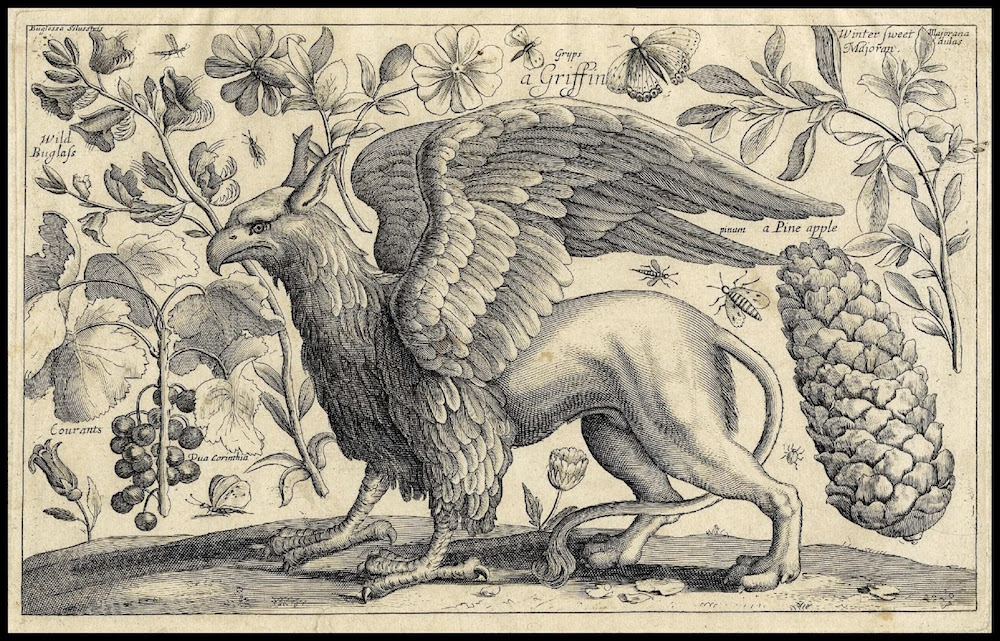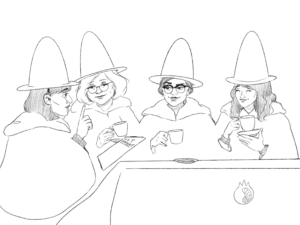Footnotes:
In past exhibits, I’ve encouraged listeners to put themselves in the shoes of folks like Mary Anning or the quarry workers who discovered the mosasaur. This time, I want you to imagine finding a strange, sharp-toothed beast that seems to be made from a hodge-podge of different animal parts. Through science and time, we’ve come to recognize these discoveries as ancient animals. We take for granted that we have entire classification systems to determine where these critters fit in the scope of deep time.
But imagine for a second that you live in a society that doesn’t yet have an understanding for the geological processes that create fossils. Imagine finding the skeleton of a monster. Logically, you’d describe the find by the scientific standards of your culture. The creature might become the stuff of myth and legend.
Today on Museum of Natural Mystery, we examine two such mythological creatures: the Cyclops and the griffin.
The Cyclops

Cyclopes are kind of B-listers when it comes to mythological creatures in our popular media, trailing behind the likes of dragons, centaurs, and hydras. The ancient Greeks envisioned the Cyclopes as a race of one-eyed giants. They were often portrayed as having empty, fleshed over sockets where human eyes would normally sit, and a single eye on their forehead. The Cyclopes were thought to be primitive in comparison to men, and therefore were described as living in caves with their meager tools and amenities. They had language, but no true society or culture.

As time passed, the Cyclops transformed into a more oafish creature, often depicted with horns, tusks, or bony beards. Today’s imagery often portrays the Cyclops with some variant on these facial structures. But what was responsible for the change in appearance?



It has long been theorized that the concept of the Cyclops sprang from Greek discoveries of ancient European elephant bones. Elephant skulls are particularly human-looking when viewed without context. Many scientists now think that the Greeks misinterpreted dwarf elephant bones as the remains of giant humans. The varying tusk arrangements of different elephant species may have influenced artistic renderings of Cyclopes.




Certainly, many modern Cyclops depictions seems to embrace and draw upon elephants for inspiration. Today’s interpretations tend to be a far cry from the creature’s beginnings.

The Griffin

Back in 2000, historian Adrienne Mayor proposed that the griffin might also be a case of mythological mistaken identity. Classical accounts of the griffin describe an animal with the body of a lion, but the head, wings, and forelimbs of an eagle.

Mayor’s research compiled pre-Greek reports of the griffin and combined them with modern paleontology, leading her to a likely candidate for the griffin’s inspiration. Or rather, several. The griffin, it seems, originates from central Asia, in an area rife with fossil specimens of two particular dinosaurs: the protoceratops and the psittacosaurus.




Fossil nests and eggs belonging to a different dinosaur, the oviraptor, are also common throughout the region.



The fossil remains of these dinosaurs are said to litter the ground in some areas of the Gobi Desert. It is a widely accepted theory that the ancient nomads who resided in the desert may have misidentified the various dinosaur skeletons or perhaps mismatched fossil bones as the remains of giant quadruped birds.
The nomads were skilled falconers, and trained raptors (birds of prey, not dinosaurs) for hunting. The protoceratops and psittacosaurus were early ceratopsian dinosaurs; they had the beaked mouths common in members of this family. The psittacosaurus in particular has a parrot-like, hooked beak that would have looked very familiar to nomads accustomed to domesticating falcons.

The protoceratops had large, protruding shoulder blades that Mayor theorizes could have been mistaken for wing joints. Protoceratops also had a head crest that, in fossil form, tends to break easily, which often leaves the skull with two spikes projecting out of the head. These may have accounted for griffins in classic artwork portrayed with elaborate head structures, horns, and “ears.”


Protoceratops and psittacosaurus remains are among the most abundant in the fossil record, and the Gobi nomads would likely have encountered caches of these fossils in the desert from time to time. It’s possible they concluded that the fossil bones, as well as the oviraptor nests, were all remains of a single animal. The resulting composite, Mayor suggests, is the griffin.
Whether tales of creatures like the Cyclops and the griffin were spawned directly from ancient peoples discovering fossil skeletons, or whether these skeletons only served to reinforce pre-existing folklore is impossible to say for certain. It does, however, beg the question: How many monsters of antiquity are just ancient animals, misidentified and distorted by time?

Sources:
Geomythology by Adrienne Mayor
The First Fossil Hunters: Dinosaurs, Mammoths, and Myth in Greek and Roman Times by Adrienne Mayor
Herodotus by Michael Scott, Strange Science
Eagles & Birds of Prey by David Burnie
Museum Management:
Museum theme by Michael Guy Bowman
Listen to more at: bowman.bandcamp.com
Rachel: Designer #UkuleleWitch @rachelvice
Tour Guide: Emery Coolcats
Twitter: @natmysterycast | Email: natmysterypodcast@gmail.com | Home: pome-mag.com/category/pomecast
Follow the show on iTunes or Soundcloud!
Museum of Natural Mystery is part of the POMEcast network, and thanks a million to the ladies of POME for helping this show get up and running! But above all, thank you for listening! We’ll see you next time!




